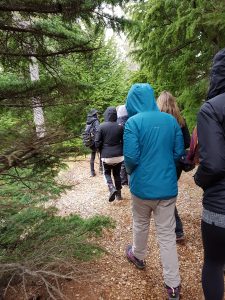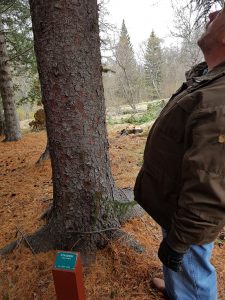As the Nordic joke goes “it is easy to find your way out from the Icelandic forests – just stand up.” (1).
At the time of settlement, Iceland was covered with about 25-40% woodlands and birch forests (2). There are very few native forest forming tree species, the main being downy birch along with other low dwelling shrubs (2). Although not a huge forest, it was important in protecting fragile volcanic soil in the hostile Icelandic environment. However with settlement came land use changes including destruction of native forests for livestock grazing land or for material uses such as fuel and timber (3). By the 20th century birch forests, or what was left of them, covered a measly 1% of Iceland (4). New laws were passed in 1907 to conserve ad renew forests and one year later the Iceland Forest Service was established (2). In the years to come an emphasis on afforestation arose. Planting by the IFS and other forestry societies resulted in 1-1.5million seedlings planted per year between 1960-1989, up to 4 million per year in the 1990s, and about 6 million per year between 2007-2009 (2). However most of these seedlings were not native species but rather exotic conifers. The most common planted species are the exotic Siberian larch and the native birch trees (1).

Planting Trees to Save the Planet
Planting trees, native or not, bring many benefits to Icelanders and the environment. One important benefits includes increased carbon sequestration by forests which may reverse some of the effects of land degredation in the past that released upwards of 450 million tonnes of carbon (3). Not only doforests sequester carbon they can also prevent further soil erosion and restore fertility and biodiversity which will further combat effects of global warming (3). Furthermore, afforestation provides social and economic benefits to the country. Forests provide a social space for recreation, connection to nature and better air quality and health (2). Although forests in Iceland are not big enough to support large scale wood production, it can provide some means of production on smaller scales such as wood for fireplaces, and small orders of lumber for private use (2).


Tree Huggers and Tree Haters
Despite these benefits there are still major concerns about afforestation projects in Iceland. Some are worried about the consequences of planting exotic species, however there is no evidence that these species negatively impact Iceland’s forest ecosystems. Others are concerned about the impacts on other land uses and the costs of continuing such projects long-term (4). But these concerns aren’t big enough to stop a little forest from growing!
ISCI 361 Goes Planting!
Through this course we got the amazing opportunity to contribute to the afforestation of Iceland first hand. Our class lead by the wonderful Caitlin Wilson through her NGO got to plant 2170 burch tree seedlings in the barren looking fields of volcanic ash soil. Hard work never felt so good!



References Cited
- Dammert, Lauri. “Dressing the Landscape: Afforestation Efforts on Iceland.” FAO Corporate Document Repository. Food and Agriculture Orginization, n.d. <http://www.fao.org/docrep/004/y2795e/y2795e09a.htm>.
- Eysteinsson, Thröstur. “Forestry in a Treeless Land.” Iceland Forest Service Egilsstaðir, Iceland, Apr. 2013. <https://rafhladan.is/bitstream/handle/10802/7037/Treeless-land_netutgafa.pdf?sequence=1>.
- Arnalds, Andres. “Carbon Sequestration and the Restoration of Land Health.” Climatic Change 65.3 (2004): 333-46.
- Freysteinsdóttir, Ragnhildhur. “Identification of Areas for Forestry at the Regional Planning Level in Iceland: Examination of a Land-Use Assessment Method.” (n.d.): n. pag. Simon Fraser University, Nov. 2003. Web. <https://www.google.ca/url?sa=t&rct=j&q=&esrc=s&source=web&cd=1&cad=rja&uact=8&ved=0ahUKEwiVuf2riMvUAhVFKGMKHY3XAuYQFggoMAA&url=https%3A%2F%2Fwww.researchgate.net%2Fpublication%2F35415251_Identification_of_areas_for_forestry_at_the_regional_planning_level_in_Iceland_microform_examination_of_a_land-use_assessment_method&usg=AFQjCNE5HQVutX6dd0es-lHDMo8MvwA0Pg&sig2=7K4s-YJIOYQnCXr_Q2IKhQ>.